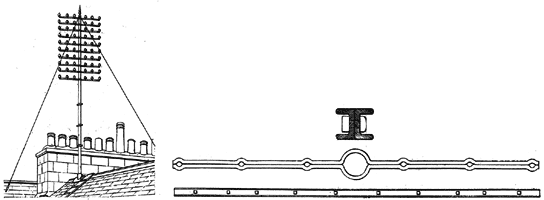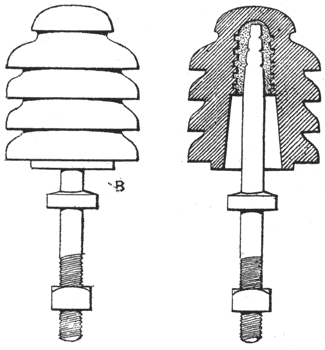[Trade Journal]
Publication: Electrical World
New York, NY, United States
vol. 14, no. 21, p. 339, col. 1-2
Telephone Line Construction in Scotland.
The recent letter of our special correspondent dated from Edinburgh gave some account of telephone line construction as practiced in Scotland, and the excellent work accomplished by Mr. A. R. Bennett, general manager of the National Telephone Company, whose lines cover the whole of Scotland, practically. The planting of poles in the streets being forbidden, it has become necessary to run the lines on the roofs of the houses; and as these are mostly of the gabled type, with very sloping roofs, the construction shown in the accompanying illustration, Fig. 1, has been adopted. The pole, it will be seen, rests on a cast-iron foot consisting of a semi-cylindrical base into which the upright pole of wrought iron fits. The pole, is guyed by two wires, and the whole makes a very stiff and neat arrangement.
 |
| Figs. 1, 2, 3, and 4. — Telephone Line Construction in Edinburgh. |
The cross-arms upon the pole are made of wrought iron and in a very substantial and neat manner. Our illustration, Fig. 3, shows the arm in section, and Figs. 3 and 4, respectively, a plan and elevation of the same. As will be seen, it consists of two channel iron bars, 1 1/4 inch wide, which are shaped to fit the tube and insulator bolts by hydraulic pressure applied, cold. Two of these bars, which are counterparts of each other, are then bolted together encircling the pole, and the insulators inserted into the holes provided for them. The tightening of the bolts effectually clamps the arm to the pole, so that no twisting occurs.
 |
| Figs. 5 and 6. — the Bennett Insulator. |
This type of pole and cross-arm were designed by Mr. A. R. Bennett several years ago, and to him is also due the design of the insulator, which is shown in elevation and in section, respectively, in Figs. 5 and 6. This insulator was designed specially for telephone work, and, as will be seen, consists of a porcelain body with a number of corrugations into which is embedded the pin. This form of insulator enables several spurs or legs to be taken off the wire at any point with great readiness, and also resists stone throwing successfully to a much greater extent than the usual Post Office pattern insulator used in England. It is evident, also, that from the increased amount of surface presented by the corrugations the insulation is necessarily higher than would be the case with a plain cylindrical insulator; and as the pole and cross-arms are of iron, instead of wood, it is evident that a good insulator is absolutely necessary on these lines, and the one designed by Mr. Bennett has fully equaled the requirements. The insulator has also been found to give excellent results for telegraph and electric light purposes.
